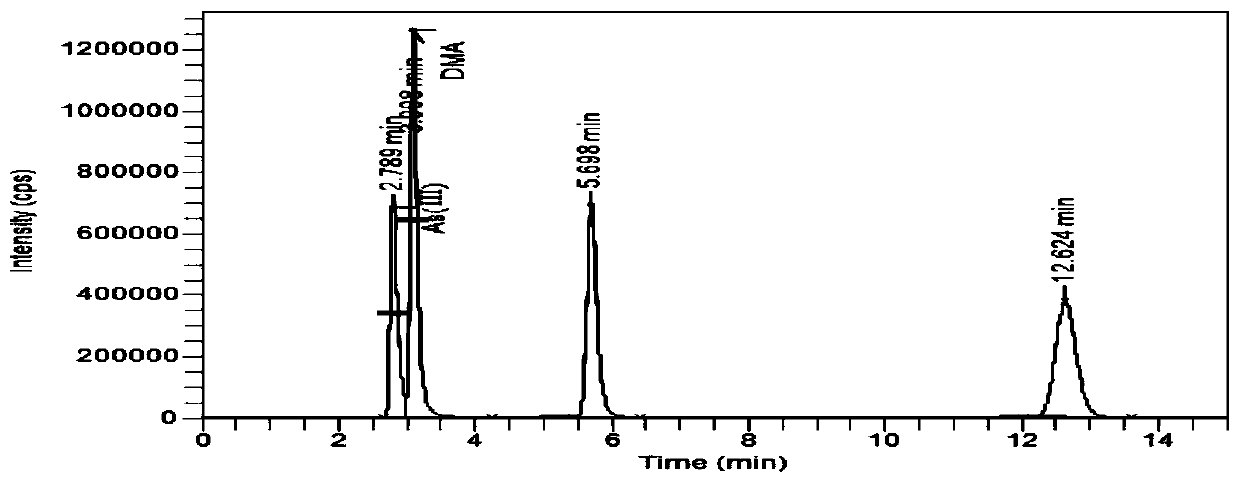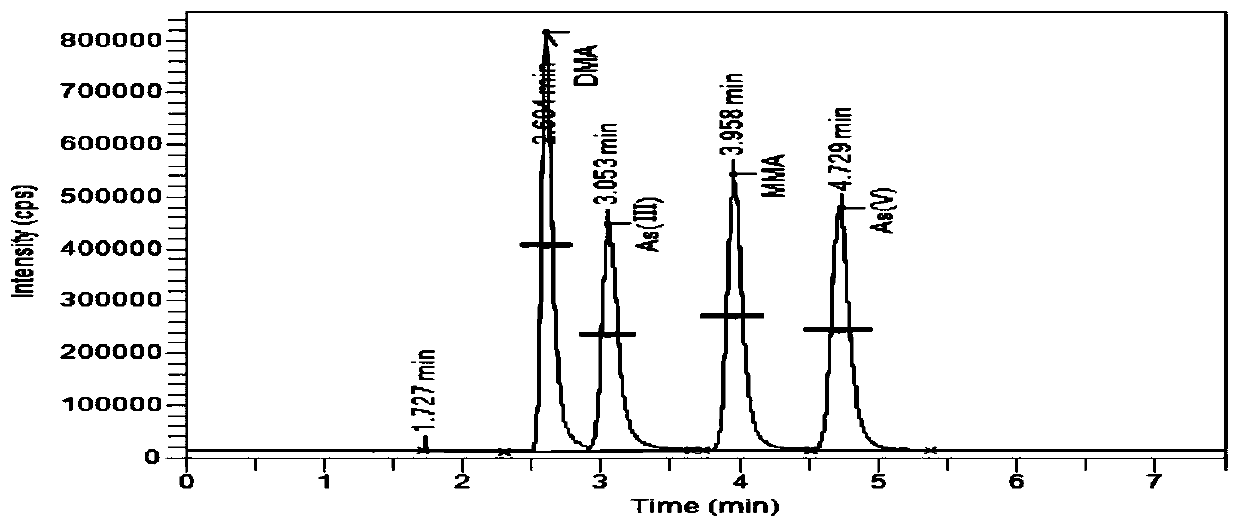Detecting of different arsenic forms in environmental water based on HPLC-ICP-MS hyphenated technology
A technology of HPLC-ICP-MS and ICP-MS, which is applied in the field of water quality environmental monitoring, can solve the problems of unscientific impact on the environment and ecology, strong toxicity and carcinogenicity of arsenic and its compounds, and achieve low and high detection limits. The effect of high sensitivity and stability
- Summary
- Abstract
- Description
- Claims
- Application Information
AI Technical Summary
Problems solved by technology
Method used
Image
Examples
Embodiment 1
[0044] Embodiment 1: Optimization of liquid chromatography separation conditions
[0045] When using HPLC-ICP-MS to analyze the arsenic species in the sample, the selection and optimization of liquid chromatography separation conditions are very critical. The present invention investigates the separation effects of four forms of arsenic, As(III), As(V), DMA and MMA, from the following four aspects.
[0046] 1.1 Selection of chromatographic column
[0047] In water, As(Ⅲ), As(V), DMA and MMA all exist in the form of anions, so they can be separated according to the ion exchange mechanism. For anion exchange columns, under common mobile phase conditions, anions As(Ⅲ), As(V), DMA, MMA interact with ion exchanger groups on the stationary phase of the column, and are eluted in sequence according to the force come out. IonPac AS19 is a conventional anion exchange column capable of separating most anions.
[0048] 1.2 Selection of mobile phase and its concentration and pH value ...
Embodiment 2
[0060] Example 2: Research on Inductively Coupled Plasma Mass Spectrometry (ICP-MS) Analytical Conditions
[0061] The present invention chooses 75 The debugging solution with As concentration of 10 μg / L (contains internal standard elements 89 Y), do experiments on the power of the instrument plasma radio frequency generator (RF), carrier gas flow, cooling gas flow, plasma gas flow, sampling depth and other conditions; the measurement process is monitored at the same time 140 Ce and its double charge 70 and oxide 156, calculated double ion yield and oxide yield.
[0062] 2.1 Effect of plasma RF power
[0063] When the plasma RF power is changed, the intensity count of the element to be detected is detected. The measured data is shown in Table 2, and the RF power is used as the abscissa, the cps is used as the ordinate on the left, and the double charge and oxide yield of Ce are plotted on the right. See Figure 8 . The graph shows that as the RF power increases, the inten...
Embodiment 3
[0080] Example 3: Confirmation of indicators for the determination of arsenic in different forms by HPLC-ICP-MS
[0081] 3.1 Detection limit and linear range of combined method
[0082] Prepare a blank sample and add a small amount of standard water sample to be tested for analysis, measure 7 times continuously, and calculate the detection limit of the method according to 3 times the relative standard deviation of the measurement results. The specific data are shown in Table 6.
[0083] It can be seen from the table that the detection limits of the four forms of arsenic (calculated as As) are: As(Ⅲ), 0.08μg / L; As(V), 0.07μg / L; MMA, 0.06μg / L; DMA, 0.05μg / L. According to the U.S. EPA SW-846, the concentration of 4 times the detection limit is used as the lower limit of determination, and the lower limit of determination is as follows: As(Ⅲ), 0.4 μg / L; As(V), 0.3 μg / L; MMA, 0.3 μg / L; DMA , 0.2 μg / L.
[0084] Table 6 Detection limit data of different forms of arsenic
[0085] ...
PUM
 Login to View More
Login to View More Abstract
Description
Claims
Application Information
 Login to View More
Login to View More - R&D
- Intellectual Property
- Life Sciences
- Materials
- Tech Scout
- Unparalleled Data Quality
- Higher Quality Content
- 60% Fewer Hallucinations
Browse by: Latest US Patents, China's latest patents, Technical Efficacy Thesaurus, Application Domain, Technology Topic, Popular Technical Reports.
© 2025 PatSnap. All rights reserved.Legal|Privacy policy|Modern Slavery Act Transparency Statement|Sitemap|About US| Contact US: help@patsnap.com



